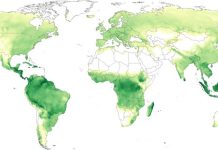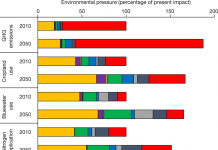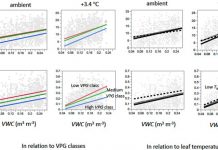【气候变化正导致青藏高原永冻土上层的碳吸收量增加】Jinzhi Ding, Leiyi Chen, Chengjun Ji, Gustaf Hugelius, Yingnian Li, Li Liu, Shuqi Qin, Beibei Zhang, Guibiao Yang, Fei Li, Kai Fang, Yongliang Chen, Yunfeng Peng, Xia Zhao, Honglin He, Pete Smith, Jingyun Fang & Yuanhe Yang. Decadal soil carbon accumulation across Tibetan permafrost regions. Nature Geoscience 10, 420–424 (2017) doi:10.1038/ngeo2945
研究认为永久冻土上层中的碳封存或有助于抵消目前正在融化的永久冻土深层所释放的碳。(来源:Nature自然科研)
Abstract
Permafrost soils store large amounts of carbon. Warming can result in carbon release from thawing permafrost, but it can also lead to enhanced primary production, which can increase soil carbon stocks. The balance of these fluxes determines the nature of the permafrost feedback to warming. Here we assessed decadal changes in soil organic carbon stocks in the active layer—the uppermost 30 cm—of permafrost soils across Tibetan alpine regions, based on repeated soil carbon measurements in the early 2000s and 2010s at the same sites. We observed an overall accumulation of soil organic carbon irrespective of vegetation type, with a mean rate of 28.0 g C m−2 yr−1 across Tibetan permafrost regions. This soil organic carbon accrual occurred only in the subsurface soil, between depths of 10 and 30 cm, mainly induced by an increase of soil organic carbon concentrations. We conclude that the upper active layer of Tibetan alpine permafrost currently represents a substantial regional soil carbon sink in a warming climate, implying that carbon losses of deeper and older permafrost carbon might be offset by increases in upper-active-layer soil organic carbon stocks, which probably results from enhanced vegetation growth.
【土壤呼吸对土壤水分的响应】Christine V. Hawkesa,1, Bonnie G. Waringa,b, Jennifer D. Roccaa,c, and Stephanie N. Kivlina,d. Historical climate controls soil respiration responses to current soil moisture. PNAS, 2017, doi: 10.1073/pnas.1620811114
Abstract
Ecosystem carbon losses from soil microbial respiration are a key component of global carbon cycling, resulting in the transfer of 40–70 Pg carbon from soil to the atmosphere each year. Because these microbial processes can feed back to climate change, understanding respiration responses to environmental factors is necessary for improved projections. We focus on respiration responses to soil moisture, which remain unresolved in ecosystem models. A common assumption of large-scale models is that soil microorganisms respond to moisture in the same way, regardless of location or climate. Here, we show that soil respiration is constrained by historical climate. We find that historical rainfall controls both the moisture dependence and sensitivity of respiration. Moisture sensitivity, defined as the slope of respiration vs. moisture, increased fourfold across a 480-mm rainfall gradient, resulting in twofold greater carbon loss on average in historically wetter soils compared with historically drier soils. The respiration–moisture relationship was resistant to environmental change in field common gardens and field rainfall manipulations, supporting a persistent effect of historical climate on microbial respiration. Based on these results, predicting future carbon cycling with climate change will require an understanding of the spatial variation and temporal lags in microbial responses created by historical rainfall.
【北极泥炭地N2O排放】Carolina Voigta,1, Maija E. Marushchaka, Richard E. Lamprechta, Marcin Jackowicz-Korczyńskib,c, Amelie Lindgrenb,d, Mikhail Mastepanovb,c, Lars Granlunda,e, Torben R. Christensenb,c, Teemu Tahvanainene, Pertti J. Martikainena, and Christina Biasia. Increased nitrous oxide emissions from Arctic peatlands after permafrost thaw. PNAS, 2017, doi: 10.1073/pnas.1702902114
Abstract
Permafrost in the Arctic is thawing, exposing large carbon and nitrogen stocks for decomposition. Gaseous carbon release from Arctic soils due to permafrost thawing is known to be substantial, but growing evidence suggests that Arctic soils may also be relevant sources of nitrous oxide (N2O). Here we show that N2O emissions from subarctic peatlands increase as the permafrost thaws. In our study, the highest postthaw emissions occurred from bare peat surfaces, a typical landform in permafrost peatlands, where permafrost thaw caused a fivefold increase in emissions (0.56 ± 0.11 vs. 2.81 ± 0.6 mg N2O m−2 d−1). These emission rates match those from tropical forest soils, the world’s largest natural terrestrial N2O source. The presence of vegetation, known to limit N2O emissions in tundra, did decrease (by ∼90%) but did not prevent thaw-induced N2O release, whereas waterlogged conditions suppressed the emissions. We show that regions with high probability for N2O emissions cover one-fourth of the Arctic. Our results imply that the Arctic N2O budget will depend strongly on moisture changes, and that a gradual deepening of the active layer will create a strong noncarbon climate change feedback.
【大气与陆地生物圈的区域性反馈】Julia K. Green, Alexandra G. Konings, Seyed Hamed Alemohammad, Joseph Berry, Dara Entekhabi, Jana Kolassa, Jung-Eun Lee & Pierre Gentine. Regionally strong feedbacks between the atmosphere and terrestrial biosphere. Nature Geoscience 10, 410–414 (2017) doi:10.1038/ngeo2957
Abstract
The terrestrial biosphere and atmosphere interact through a series of feedback loops. Variability in terrestrial vegetation growth and phenology can modulate fluxes of water and energy to the atmosphere, and thus affect the climatic conditions that in turn regulate vegetation dynamics. Here we analyse satellite observations of solar-induced fluorescence, precipitation, and radiation using a multivariate statistical technique. We find that biosphere–atmosphere feedbacks are globally widespread and regionally strong: they explain up to 30% of precipitation and surface radiation variance in regions where feedbacks occur. Substantial biosphere–precipitation feedbacks are often found in regions that are transitional between energy and water limitation, such as semi-arid or monsoonal regions. Substantial biosphere–radiation feedbacks are often present in several moderately wet regions and in the Mediterranean, where precipitation and radiation increase vegetation growth. Enhancement of latent and sensible heat transfer from vegetation accompanies this growth, which increases boundary layer height and convection, affecting cloudiness, and consequently incident surface radiation. Enhanced evapotranspiration can increase moist convection, leading to increased precipitation. Earth system models underestimate these precipitation and radiation feedbacks mainly because they underestimate the biosphere response to radiation and water availability. We conclude that biosphere–atmosphere feedbacks cluster in specific climatic regions that help determine the net CO2 balance of the biosphere.
【绿叶丰度增加是一把双刃剑】Giovanni Forzieri1,*, Ramdane Alkama1, Diego G. Miralles2, Alessandro Cescatti1. Satellites reveal contrasting responses of regional climate to the widespread greening of Earth. Science, 2017, doi: 10.1126/science.aal1727
一则新的全球评估报告显示,绿叶丰度的增加正引起北方寒带地区变暖及干旱地区变冷。这些结果提示,在制定局部的缓解气候变化和适应计划时,应考虑全球植被近来的变化对局部气候产生的影响。由于大气中二氧化碳增加、氮沉积、全球暖化和土地使用改变,地球有相当大的部分正在变绿。绿叶覆盖(或叶面积指数,LAI)的增加对气候变化反馈回路具有重要意义,然而,要在全球范围内对这些影响力进行量化分析会是很大的挑战。在这里,Giovanni Forzieri和同事分析了1982-2011年间全球LAI覆盖的卫星数据。他们得到的结果因局部生物群系而异:在北方寒带地区,LAI增加会造成表面反射(即对日光的反射)减少,因此导致暖化效果;相反,在干旱地区,LAI的增加会令蒸腾作用增加,因而会驱动冷却效应。更重要的是,作者发现,LAI和表面生物物理反应间的这些关系会在极端暖和-干燥及寒冷-潮湿的年份中被放大5倍之多。他们估计,在全球约60%的植被地区,绿化可缓冲暖化的幅度约为14%;但对其它地区(它们大多包括寒带地区)而言,LAI的发展趋势则放大了气温的上升幅度,导致暖化额外增加了约10%。(来源:EurekAlert!)
Abstract
Changes in vegetation cover associated to the observed greening may affect several biophysical processes, whose net effects on climate are unclear. Here, we analyze remotely sensed dynamics in leaf area index (LAI) and energy fluxes to explore the associated variation in local climate. We show that the increasing trend in LAI contributed to the warming of boreal zones through a reduction of surface albedo, and to an evaporation-driven cooling in arid regions. The interplay between LAI and surface biophysics is amplified up to five times under extreme warm-dry and cold-wet years. Altogether, these signals reveal that the recent dynamics in global vegetation have had relevant biophysical impacts on the local climates and should be considered in the design of local mitigation and adaptation plans.








